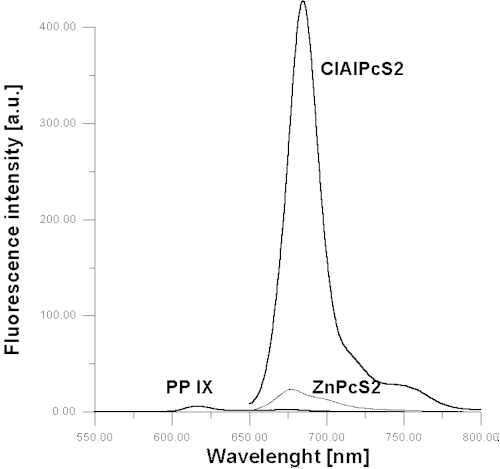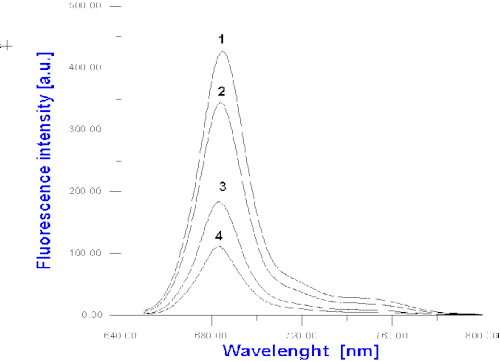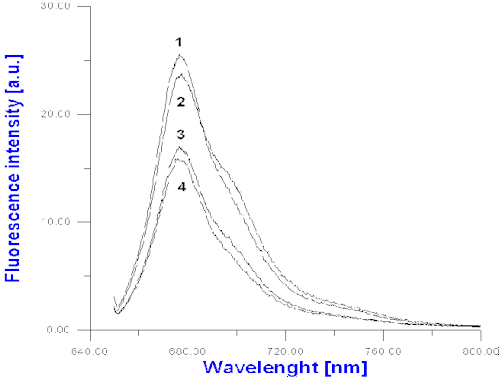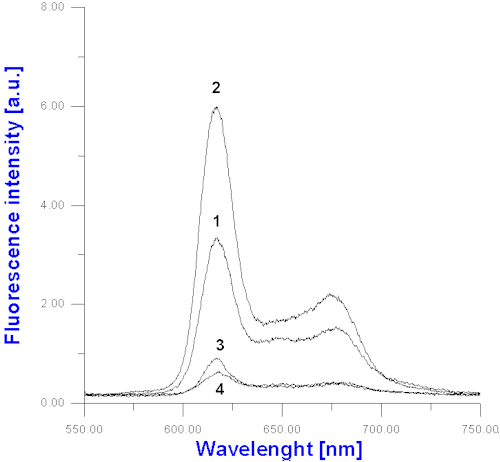SPECTRAL PROPERTIES OF THE PHTHALOCYANINES AND THEIR PHOTOTOXICITY
Hana Kolarova, Roman Kubínek, Miroslav Strnad
Centre of Molecular Biology and Medicine, Palacký University Olomouc,
Department of Biophysics, Faculty of Medicine, Palacký University, Olomouc, Czech Republic
E-mail: KOL@risc.upol.cz, KUBIN@risc.upol.cz
Introduction
In photodynamic therapy (PDT), a sensitizer, light, and oxygen are used to cause photochemically induced cell´s death. The mechanism of phototoxicity involves generation of singlet oxygen and other free radicals when the lightexcited senzitizer loses or accepts an electron.
Efficiency of PDT is affected by factors included:
absorption spectrum of the photosensitizer
wavelenght of the activation light
depth of the light penetration in the tissue
biological tissue answer on singlet oxygen
There are four properties that would make a sensitizer optimal for PDT.
selective retention in tumorous tissue
fast removing from healthy tissue, first of all from skin and eyes
possibility of the activation by longer and depthly penetrating wavelenght
featureless toxicity
Types of photosensibilisers
Phthalocyanines, chlorines and 5-aminolevulinic acid present a new generation of substances for photodynamic treatment of tumors.
Protoporphyrin IX production after systemic 5-aminolevulinic acid administration is very tissue specific.
Phthalocyanines can be chelated with a variety of metals, chiefly aluminium and zinc, and these diamagnetic metals enhance the phototoxicity. Less sulfonated compounds, which are more lipophilic, exhibit the best membrane-penetrating properties and are the most active.
To find optimal therapeutic doses for i. v. or local application, it was necessary to test:
the maximum non-toxic concentration
minimum phototoxic level relate to laser irradiation in different model systems.
Standard testing system for definition of the in vitro cytotoxicity and phototoxicity:
splenocytes obtained from rabbit spleen fragments
B16 pigmented melanoma
Spectral properties of the photosensitizers
Absorption spectra
The absorption spectra were measured with a spectrometer Pye-Unicam SP8-100. The used concentration of photosensitizers was 1.10-5 M, pH=7.6 (buffer Tris-HCl).
The phthalocyanines have big absorption in UVA region of the electromagnetic spectra with maximum of the peak 350 nm and in visible region of the spectra between 650 and 700 nm with maximum in 670 nm.
PPIX has most absorption in UVA region of electromagnetic spectra with absorption maximum about 370 nm. Absorption declines in visible region and absorption nearly zero for wavelenght 700 nm. Phthalocyanines are the most suitable for their absorption in longwave range of the spectra.
Semiconductor laser with power of 50 mW and 670 nm was chosen, because its wavelenght corresponded with absorption maximum in longwave region of the visible part of electromagnetic spectra.
Fluorescence spectra
Emission and excitation fluorescence spectra of ClAlPcS2, ZnPcS2 and PPIX photosensitizers in water solution were measured. The range of the concentration from 0.09 m g/ml to 9 m g/ml for fluorescence and absorption spectral measurement were used. Fluorescence spectra were measured with spectrofluorimeter HITACHI F4500.
The maximum intensity of fluorescence for PPIX is at wavelenght 617 nm and 673 nm, for ClAlPcS2 at 677 nm and for ZnPcS2 at 677 nm. ClAlPcS2 phthalocyanine has the highest fluorescence intensity at the same observed conditions.

emission spectra: c = 9m g/ml;
excitation wavelenght = 640 nm
Fluorescence spectra of CAlPcS2 for different concentrations

emission spectra: excitation wavelenght = 640 nm
(1) c1 = 9 m g/ml, (2) c2 = 4,5 m g/ml, (3) c3 = 1,8 m g/ml, (4) c4 = 0,9 m g/ml
Fluorescence spectra of ZnPcS2 for different concentrations

emission spectra: excitation wavelenght = 640 nm
(1) c1 = 9 m g/ml, (2) c2 = 4,5 m g/ml, (3) c3 = 1,8 m g/ml, (4) c4 = 0,9 m g/ml
Fluorescence spectra of PPIX for different concentrations

emission spectra: excitation wavelenght = 640 nm
(1) c1 = 9 m g/ml, (2) c2 = 4,5 m g/ml, (3) c3 = 1,8 m g/ml, (4) c4 = 0,9 m g/ml
Photosensitizers
Phthalocyanines ClAlPcS2 and ZnPcS2 were prepared by Jan Rakušan in Research Institute for Organics syntheses in Rybitví (Czech Republic).
Test of the migration activity of splenocytes
Test of the migration activity of splenocytes with laser radiation only
The migration activity of splenocytes derived from rabbit spleen fragments was determined as follows. An aseptically excised rabbit (Chinchila) spleen was cut on a sterile paraffin plate into pieces about 1 mm in diameter. These fragments were washed in MEM and than were placed into wells (Dynatech plates 8 x 12, flat bottom). MEM with 10% FCS in total volume of 0,15 ml was added into each wells. Splenocytes in wells were irradiated by laser before incubation without addition of photosensitizers. Laser irradiation of wavelenght 670 nm at dose from 50 J/cm2 to 1000 J/cm2 was used. The controls contained fragments in a cultivation medium were not irradiated. After 24 hours cultivation at 37 oC in 5% CO2, migration zones of the spleen cells were measured. The results are presented as the migration index (MI - the ratio between the experimental migration zone and the control zone).
The doses from 50 J/cm2 to 1000 J/cm2 didn´t significantly influence migration activity of the splenocytes.
Test of the migration activity of splenocytes with ClAlPcS2 and ZnPcS2 photosensitizers without irradiation
The splenocytes for this experiment were obtained by the same way as in the previous case. Each concentration of ClAlPcS2 or ZnPcS2 (0.1 - 1.4 mg/ml) was placed into four wells, one fragment was transferred into each well. The controls contained fragments in a cultivation medium only. After 24 hours of cultivation at 37 oC in 5% CO2 migration zones of the spleen cells were measured. The results are presented as the migration index (MI - the ratio between the experimental migration zone and the control zone).
The test used for determination of the migration activity of splenocytes did not show influences on MI in the concentration range of 0.1 - 0.5 mg/ml for ClAlPcS2 and 0,1 - 0,2 mg/ml for ZnPcS2. The higher tested concentrations lead to reduction of the migration activity presented by decreasing in the migration index MI:
ClAlPcS2 - c = 0.6 mg/ml, MI = 0.85, at c = 1.4 mg/ml, MI = 0.45.
ZnPcS2 - c = 0.3 mg/ml, MI = 0.8, at c = 1.4 mg/ml, MI = 0.4.
(normal value for MI is in the range 0.9 - 1.1).
Migration activity of splenocytes for finding of the optimal combination of concentration of ClAlPcS2 and ZnPcS2 photosensitizers and laser irradiation
Splenocytes for this experiment were obtained by the same way as in the previous case. Each concentration (0.005 - 0,06 mg/ml) was placed into four wells, one fragment was transferred into each well. The controls contained fragments in a cultivation medium only. Fragments were irradiated after 3 hours of cultivation at 37 oC in 5% CO2 at doses from100 J/cm2 to 400 J/cm2. Migration zones of the spleen cells were measured. The results are presented as the migration index (MI - the ratio between the experimental migration zone and the control zone). Area of migrations zones was evaluated by some image analyses methods.
Changes of migration index in dependancy on ClAlPcS2 concentration and irradiation doses

Changes of migration index in dependancy on ZnPcS2 concentration and irradiation doses

The optimal combination of phototoxic concentration and laser irradiation of wavelenght 670 nm was 0.02mg/ml (ClAlPcS2) at dose of 300 J/cm2 and 0.01 mg/ml (ZnPcS2) at dose of 200 J/cm2. The statistic evaluation of results was based on analyses of the variance at twice sorting. Significant influence of the levels of irradiation doses to folowed quantity (p < 0.05) was proved. Analysis of the variance was completed by Duncan test.
Phototoxicity of ClAlPcS2 and ZnPcS2 photosensitizers for B 16 melanoma cellS
Twice washed tripsinized melanoma B 16 cells were divided in amount 104 to each well and filled in RPMI with 10% FCS in total volume 0.1 mg/ml. After 24 hours of cultivation at 37 oC in 5% CO2 the fotosensitizer was added. Finally the photosensitizers concentration (ClAlPcS or ZnPc) was mixed from 0.005 m g/ml to 0.3 mg/ml in total volume 0.15 ml. Melanoma B 16 cells in mixture with photosensitizers were cultivated for 3 hours. Then the cells were irradiated by laser of wavelenght 670 nm at dose from 100 J/cm2 to 400 J/cm2. Morphological state of the melanoma B16 cells has been observed during next cultivation in inversion fluorescence microscope Olympus IX 70. Vitality of B16 cells was evaluated 24 hours after irradiation.
The optimal phototoxic effect on B16 melanoma at 9 m g/ml ZnPcS2 in combination with laser irradiation 100 J/cm2 was observed. This concentration and dose killed all melanoma B16 cells.
Conclusion
Phthalocyanines represent a new generation of substances for photodynamic treatment of tumors. To find optimal therapeutic doses for i. v. or local application, it was necessary to test the maximum non-toxic concentration and minimum phototoxic level relate to laser irradiation in different model systems. As a standard testing system for definition of the in vitro cytotoxicity and phototoxicity, splenocytes obtained from rabbit spleen fragments and B16 pigmented melanoma were chosen. The highest non-toxic concentrations of ClAlPcS2 and ZnPc on splenocytes were 0.5 mg/ml and 0.2 mg/ml respectively. The optimal combination of phototoxic concentration and laser irradiation of wavelenght 670 nm was 0.02mg/ml (ClAlPcS2) at dose 300 J/cm2 and 0.01 mg/ml (ZnPc) at dose 200 J/cm2.
The optimal phototoxic effect on B16 melanoma was observed 0.009 mg/ml ZnPc in combination with laser irradiation 100 J/cm2. This concentration and dose killed all B16 melanoma cells. The mechanism of the cells dead is further studied.